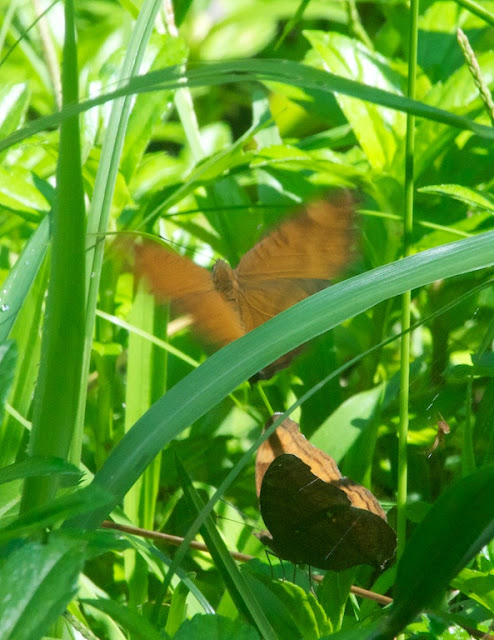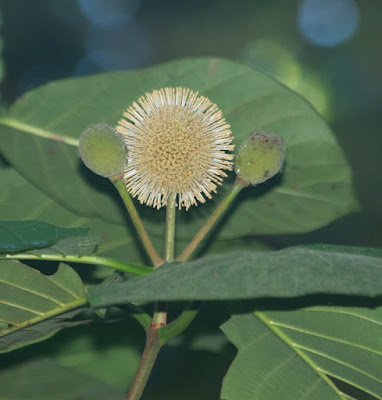A walk up the entrance road will always be enlivened by butterflies of various species feeding at the roadside plants. A stranger to the tropics, though, might well be surprised to find that most of the butterflies you can see here are comparatively small and, as often as not, patterned mostly in shades of brown. Skippers in particular can be rather dull-coloured, though the Bright Red Velvet Bob (Korithaialos sindu) boasts an unusual splash of colour (Borneo lacks the truly brilliant skippers that enliven the tropics in Latin America).
Among the commonest, and plainest, of the roadside butterflies are the members of the genus Ypthima. Thay can be difficult to identify, but I am reasonably confident that this one is a Common Three-Ring (Yphthima pandocus).
Like Yphthima, the genus Eurema - the grass yellows - contains a number of very similar, small butterflies that one frequently finds low in roadside vegetation.
Another basically brown butterfly, with its own pattern of eyespots, is the Brown Pansy (Junonia hedonia). It is one of the plainer members of its genus.
The sexes are pretty much alike, but this male seemed to have no difficulty in identifying a potential mate.
As in many butterflies, pheromones may play a part here.
A rather more striking denizen of the forest edge is the Yellow Glassy Tiger (Parantica aspasia). This butterfly is mimicked by both a related butterfly and a moth, but I believe this, indeed, a Yellow Glassy Tiger and not one of its imitators.
Getting a good photo of a Rustic (Cupha erymanthis) can be tricky; they can be both energetic and flighty.
Tanaecia is a genus of forest-floor butterflies that feed on fallen fruits and rarely, if ever, visit flowers. They can be difficult to identify without detailed examination of their genitalia, but this one may be T. orphne.
As in many butterflies, pheromones may play a part here.
A rather more striking denizen of the forest edge is the Yellow Glassy Tiger (Parantica aspasia). This butterfly is mimicked by both a related butterfly and a moth, but I believe this, indeed, a Yellow Glassy Tiger and not one of its imitators.
Getting a good photo of a Rustic (Cupha erymanthis) can be tricky; they can be both energetic and flighty.
Tanaecia is a genus of forest-floor butterflies that feed on fallen fruits and rarely, if ever, visit flowers. They can be difficult to identify without detailed examination of their genitalia, but this one may be T. orphne.
Open areas along the roadside may be spanned by the enormous webs of the Golden Orb Weaver (Nephila pilipes).
Dragonflies at Kubah tend to fall into two categories: open-country and edge species, like this Orthetrum chrysis, that you can find along the roadside, and “true” forest species that may bask in patches of sunshine beneath the trees but rarely emerge into larger open areas.
The shadows around the frog pond, for example, are almost always brightened by a glittering, golden-eyed male Cratilla metallica perched over the water, guarding its territory, but I rarely see this common forest species on the roadside edge only a few yards away.
I love the frog pond, whether by night or by day. You never know what you will see from the boardwalk that circles it - perhaps, for example, a Three-keeled Ground Skink (Mabuya rudis) stretched out in a patch of sunlight.
The frog pond often turns up the sighting of the day. In this case it was a lovely little mammal that I do not recall having seen before, the Three-striped Ground Squirrel (Lariscus insignis). This is supposed to be a "shy, nervous" species, and this one lived up to the description. I was only able to get this photo as it streaked off into the forest.


























No comments:
Post a Comment